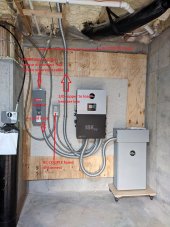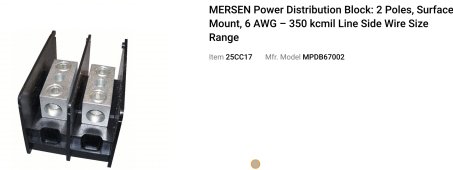I don’t think it can be done that way. Maybe someone else can chime in on this.Coming out of the main panel to the Grid input of the 18KPV and then back to the main panel from the Load output in the 18kpv to the main panel.
You are using an out of date browser. It may not display this or other websites correctly.
You should upgrade or use an alternative browser.
You should upgrade or use an alternative browser.
EG4 18kPV Q+A general thread
- Thread starter SignatureSolarJames
- Start date
why are you hooking the grid side of the inverter to the main load at all? What you describe is a circular path... what is your overall set up in terms of solar, battery, generator, grid?Coming out of the main panel to the Grid input of the 18KPV and then back to the main panel from the Load output in the 18kpv to the main panel.
why are you hooking the grid side of the inverter to the main load at all? What you describe is a circular path... what is your overall set up in terms of solar, battery, generator, grid?
Probably because I don't understand how it should be done, which is why I am here.
OK no problem just wasn't sure if I was missing something. But what are the components in your set up? Grid or grid-less, solar or no solar, battery or no battery? If grid, what Amperage is your service? Inverter covering all loads or critical loads? Etc. Would help us to know those
OK no problem just wasn't sure if I was missing something. But what are the components in your set up? Grid or grid-less, solar or no solar, battery or no battery? If grid, what Amperage is your service? Inverter covering all loads or critical loads? Etc. Would help us to know those
I have 32 panels 370 watts each that I plan to organize into 4 strings of 328w at 10.79 amps
My house is currently connected to the grid with a 200a panel which has a sub panel in the basement 100' away which runs off of a 100 amp breaker.
I will have batteries, but do not have them now. I was thinking of 6 EG4s.
My grid supplier tells me I use 32-34 kw per day.
My goal is to "cut the cable" when possible or when it fails, so the inverter will need to cover all loads.
I have a 12kw generator which supplies enough to run the entire house when the power goes out.
I use propane for heat and some cooking.
G
Great, that helps a ton. Last question: do you have any breakers upstream from the 200A load box? Like is there a breaker outside on or next to the utility service, that when you flip it cuts all power to the load box? Or is the 200A breaker in the load box the only breaker between meter and you?
Yes that's the only breaker.Great, that helps a ton. Last question: do you have any breakers upstream from the 200A load box? Like is there a breaker outside on or next to the utility service, that when you flip it cuts all power to the load box? Or is the 200A breaker in the load box the only breaker between meter and you?
I am beginning to suspect that I will have to break the incoming line?
I believe you have only two choices given those parameters:
1) you can use a supply side tap which will require the utility turning off the power while you tap into the lines from the meter, see the supply side tap w whole home backup diagram in the manual.
2) You can install a 200A breaker between the meter and the load center which also requires utility to turn off power, and then use a feeder tap that comes off the leg running from the new 200A breaker to the load panel, see feeder tap w whole home backup diagram in manual.
You can't connect to the utility by backfeeding through a breaker in the main panel because that method maxes out at 70A which isn't enough for your whole home backup
1) you can use a supply side tap which will require the utility turning off the power while you tap into the lines from the meter, see the supply side tap w whole home backup diagram in the manual.
2) You can install a 200A breaker between the meter and the load center which also requires utility to turn off power, and then use a feeder tap that comes off the leg running from the new 200A breaker to the load panel, see feeder tap w whole home backup diagram in manual.
You can't connect to the utility by backfeeding through a breaker in the main panel because that method maxes out at 70A which isn't enough for your whole home backup
I believe you have only two choices given those parameters:
1) you can use a supply side tap which will require the utility turning off the power while you tap into the lines from the meter, see the supply side tap w whole home backup diagram in the manual.
2) You can install a 200A breaker between the meter and the load center which also requires utility to turn off power, and then use a feeder tap that comes off the leg running from the new 200A breaker to the load panel, see feeder tap w whole home backup diagram in manual.
You can't connect to the utility by backfeeding through a breaker in the main panel because that method maxes out at 70A which isn't enough for your whole home backup
Do you know what the Grid input on the 18k is designed to take?
After reviewing the whole home backup diagram, I have come to realize this inverter is even more sophisticated than I originally thought.
Which is even more than my original motivation to buy it.
So theoretically a person could run some 3/0 directly from the meter to the Grid input of the 18k and then some 3/0 out of the load side of the 18k into the main load panel through it's 200a breaker.
Yes?
Which is even more than my original motivation to buy it.
So theoretically a person could run some 3/0 directly from the meter to the Grid input of the 18k and then some 3/0 out of the load side of the 18k into the main load panel through it's 200a breaker.
Yes?
That is exactly what I did...except I was lucky in that I had a 200A service disconnect right by my meter, so I didn't have to cut POCO power to hook things up.After reviewing the whole home backup diagram, I have come to realize this inverter is even more sophisticated than I originally thought.
Which is even more than my original motivation to buy it.
So theoretically a person could run some 3/0 directly from the meter to the Grid input of the 18k and then some 3/0 out of the load side of the 18k into the main load panel through it's 200a breaker.
Yes?

Every time I look at this picture I regret not putting in the work/$ for a gutter. Learn from my functional yet hideous mistake.
EDIT: I don't know how to spell entrance.
Last edited:
Yes you can connect grid directly into the inverter Grid input and connect inverter Load output directly to the 200A breaker in the load panel. The only problem with this set up compared to using taps/splitters is you cannot easily bypass the inverter in case of an inverter malfunction or failure. The feeder and supply tap diagrams in the manual include a three-way switch that allows you to switch the load panel back to utility power only, bypassing the inverter.
One of the things I'm missing for sure.Yes you can connect grid directly into the inverter Grid input and connect inverter Load output directly to the 200A breaker in the load panel. The only problem with this set up compared to using taps/splitters is you cannot easily bypass the inverter in case of an inverter malfunction or failure. The feeder and supply tap diagrams in the manual include a three-way switch that allows you to switch the load panel back to utility power only, bypassing the inverter.
But I did specifically leave my wire runs long enough to move the "load" runs over to my basement 200A disconnect and bypass the inverter if that were to happen. Won't be fun, but won't take more than an hour.
Have you priced double-throw switches lately? Like Justice Potter Stewart once said, “I know obscenity when I see it.”Just need to find a switch that is two position. On-Off-On
That’s not something I would do.But there’s a lot of room in that 18kpv. Could mount a distribution block and save some money.
Similar threads
- Replies
- 43
- Views
- 2K
- Replies
- 7
- Views
- 219
- Replies
- 49
- Views
- 3K
- Replies
- 15
- Views
- 684



